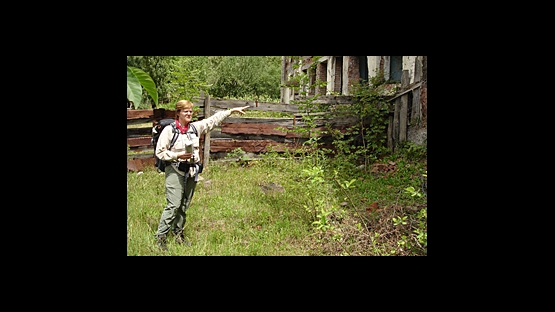Two abandoned and potentially dangerous radioactive devices have been successfully secured in the first three days of a new effort to trace lost radioactive sources in Georgia. Such abandoned sources are known as orphan sources.
A Georgian Ministry of Environment and IAEA team, scouring the isolated alpine region of Racha, found a powerful source in a pile of dirt on the floor of a derelict factory. The team also found a second smaller source inside a house - in a tin of nuts and bolts above a work bench. Just a thin, wooden wall separated the source from the family bedroom.
In the village of Iri, where the first source was located, background radiation levels were elevated 12 times above normal in the village centre.
"It could have resulted in serious injuries, or even death, if someone had picked it up and put it in their pocket for a period of time," said Carolyn Mac Kenzie, a radiation source specialist in the IAEA, who accompanied the start-up of the mission.
Villagers were shocked by the discoveries. "Of course no one had any idea it was here," said 14 year old Salome Gagnigze, standing near the derelict factory in Iri as Georgian inspectors equipped with sensors combed the complex of ruined buildings.
An animal shelter is among the ruins but continues to be used as a place of storage for farmers. Neatly stacked bean poles stand a few metres from where the source was found.
In the second village, Likhaura, residents requested investigators to check their houses for possible sources after the discovery.
The radioisotope in both sources was Caesium 137, a powerful gamma emitter, among the most common radioactive isotope in industrial use for instrumentation to check materials for flaws and for industrial measurements. New, powerful, backpack-mounted instrumentation with which the search team was equipped helped reveal and locate both sources.
Because records are not available, search team leaders said they had no clear knowledge of the origin of the sources. The first source may have been overlooked when the factory was abandoned - the second was presumably picked up and taken to the house where it was found. Both would originally have been contained in shielded containers.
As many as 300 radioactive sources have been recovered in Georgia since the mid 1990´s and there has been at least one death and many injuries to the public as a consequence.
Among the most powerful orphan sources found have been unshielded strontium 90 sources that powered radioisotope thermoelectric generators (RTGs). Some RTGs, originally located in remote areas as stand-alone electrical generators remain unaccounted for.
A legacy of Georgia´s sharp economic decline after the break-up of the Soviet Union was a loss of control of radioactive sources used in industry. The collection and sale of scrap metal from abandoned factories has also provided a means of livelihood and some orphan sources have been found in shipments of scrap. Many orphan sources have also been found on former military bases.
An added impetus to recovery operations is concern that some radioactive sources could be used for radiological dispersal devices (RDDs) if they fell into the hands of terrorists.
Since 1997 the IAEA has been working with Georgia to upgrade levels of radiation safety and to secure orphan sources. The current search and recovery mission, funded by the United States through the IAEA´s Technical Cooperation Program, is scouring the mountainous region of Racha, about 300 km north-west of the capital Tbilisi, focusing on former industrial centres in the valleys of the Rioni River. It is the last area of Georgia to have gone unchecked for orphan sources.
But the problem of unaccounted for radioactive sources is not confined to Georgia, said Ms. Mac Kenzie. "Although there have been significant strides in improved security, there are frequent reports of incidents where sources go missing and accidents occur. This is a global problem, an indication that the control and management of radioactive sources still needs to be improved. Yet radioactive sources are an irreplaceable tool providing a huge benefit to society, in the practice of medicine, in industry and research."
The technical assistance provided by the IAEA to Georgia is part of its global effort to improve the security of radioactive sources and nuclear material. Georgia is nearing the final steps of commissioning a new secure storage facility where radioactive sources will be stored.



